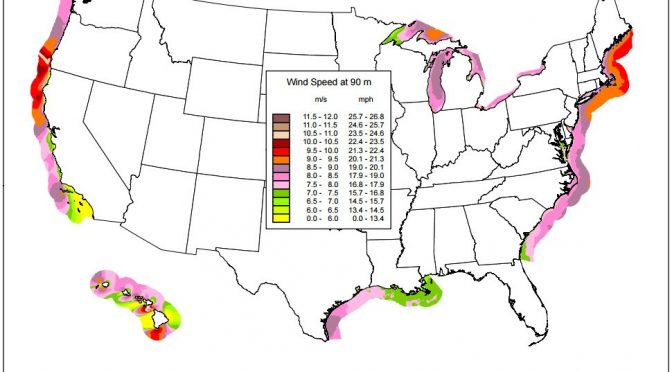Two Norwegian oil and gas leaders, oil major Equinor and offshore engineering company Aker Solutions, have joined forces with a coalition of renewable power companies to push for offshore wind development in waters off California.
The new Offshore Wind California coalition is calling upon the state of California to commit to a goal of at least 10 GW of offshore wind power by 2040, helping the state achieve its target of 100 percent renewable power by 2045. The group notes that U.S. East Coast states have about 22 GW worth of offshore wind commitments and are projected to see an estimated $70 billion in related supply chain spending by 2030.
With new advances in floating offshore wind, a technology derived from the offshore oil and gas industry, wind operators believe that they could unlock the power potential of California’s deep offshore waters. The National Renewable Energy Laboratory (NREL) estimates California’s potential for offshore wind at about 112 GW, including about 8.4 GW in three Bureau of Ocean Energy Management designated study areas. Building 10 GW of offshore wind power in California could create 18,000 jobs and generate $20 billion in economic activity by mid-century, according to NREL’s estimates.
Sunny Gupta, the head of new markets for wind developer Ørsted and the chairman of the new coalition, said that California’s offshore winds are an attractive prospect: they are steady and powerful, and they grow stronger after sunset. Power generation at most onshore wind farms in California generally peaks overnight, according to a 2010 resource assessment.
Floating platforms are a basic requirement for most of California’s offshore waters, which are too deep to support monopile or multi-leg jackets. Statoil (now Equinor) developed the world’s first operational floating wind farm, Hywind, at a location off Aberdeenshire, Scotland in 2017, and it believes the technology is ready for widespread commercial deployment. Hywind’s five mega-turbines each sit atop a 250-foot-deep ballasted cylindrical buoy, much like a spar platform. With the overwhelming majority of the world’s offshore wind potential located in deep waters, Equinor believes that its floating wind system has an important role to play.
Last year, Aker Solutions invested in Principle Power, a California-based offshore wind platform developer with its own floating wind design. “We see a major opportunity in offshore floating wind where demand is growing in the transition to a low-carbon future,” said Aker Solutions CEO Luis Araujo at the time of the announcement. “Combining our capabilities with Principle Power’s technology will help advance floating solutions for offshore wind.”
In addition to Aker, Statoil, Ørsted and Principle Power, other coalition members include California startup Magellan Wind, energy research funder Pacific Ocean Energy Trust and global power developers Mainstream Renewable Power and Northland Power.
Regulatory uncertainty
Any West Coast offshore wind development would require permitting from the U.S. Department of the Interior’s Bureau of Ocean Energy Management (BOEM). In August, the agency delayed permitting for the first American utility-scale development, the 800 MW Vineyard Wind project, calling for more study on the effects of the industry as a whole on fisheries and other stakeholders. Its stance has drawn criticism from offshore wind proponents and from elected officials on the Eastern Seaboard. In particular, BOEM’s decision to seek an extended regulatory review casts uncertainty on the availability of federal tax credits for Vineyard Wind, as the credits expire on a set timetable.
The National Offshore Industries Association (NOIA), the trade group for America’s offshore oil and gas contractors, described BOEM’s decision as a disappointing development. “We encourage all the federal agencies to view this project on its individual merits, benefits and environmental impacts when reaching permitting decisions,” said NOIA VP Tim Charters. “We expect that DOI will continue to work diligently to complete their environmental review of this crucial project. NOIA continues to believe that Vineyard is a win-win for the American people, the offshore energy industry and the environment.”
At the time of the announcement, Sen. Edward Markey (D-MA) alleged that BOEM’s regulatory approach “sends a clear and chilling message across this nascent industry that the Trump Administration will do everything in its power to cut corners for oil and gas projects while cutting the [cord] on the next frontier of clean energy deployment.” BOEM says that it took its decision in response to comments from other agencies and stakeholders.
maritime-executive.com


